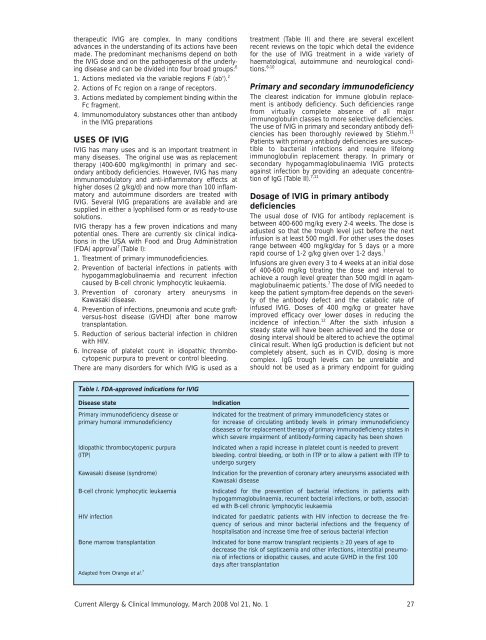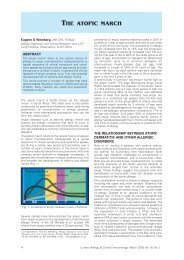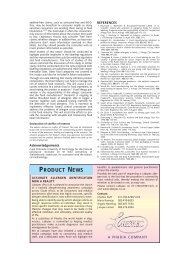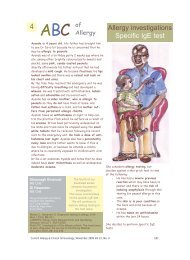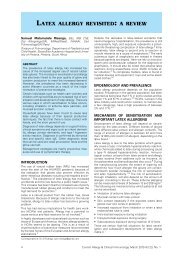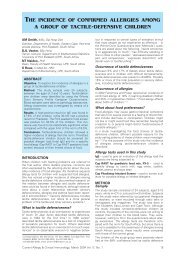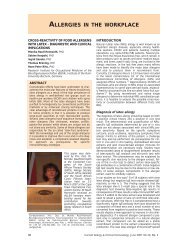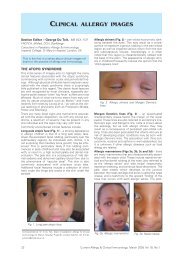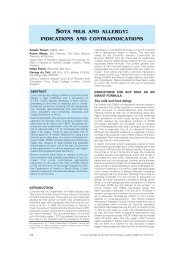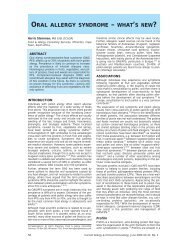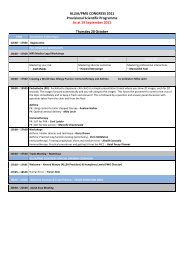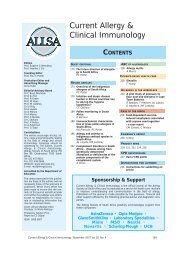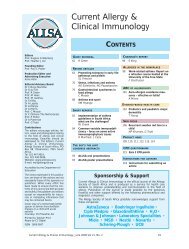Current Allergy and Clinical Immunology - March 2008
Current Allergy and Clinical Immunology - March 2008
Current Allergy and Clinical Immunology - March 2008
Create successful ePaper yourself
Turn your PDF publications into a flip-book with our unique Google optimized e-Paper software.
therapeutic IVIG are complex. In many conditionsadvances in the underst<strong>and</strong>ing of its actions have beenmade. The predominant mechanisms depend on boththe IVIG dose <strong>and</strong> on the pathogenesis of the underlyingdisease <strong>and</strong> can be divided into four broad groups: 61. Actions mediated via the variable regions F (ab'). 22. Actions of Fc region on a range of receptors.3. Actions mediated by complement binding within theFc fragment.4. Immunomodulatory substances other than antibodyin the IVIG preparationsUSES OF IVIGIVIG has many uses <strong>and</strong> is an important treatment inmany diseases. The original use was as replacementtherapy (400-600 mg/kg/month) in primary <strong>and</strong> secondaryantibody deficiencies. However, IVIG has manyimmunomodulatory <strong>and</strong> anti-inflammatory effects athigher doses (2 g/kg/d) <strong>and</strong> now more than 100 inflammatory<strong>and</strong> autoimmune disorders are treated withIVIG. Several IVIG preparations are available <strong>and</strong> aresupplied in either a lyophilised form or as ready-to-usesolutions.IVIG therapy has a few proven indications <strong>and</strong> manypotential ones. There are currently six clinical indicationsin the USA with Food <strong>and</strong> Drug Administration(FDA) approval 7 (Table I):1. Treatment of primary immunodeficiencies.2. Prevention of bacterial infections in patients withhypogammaglobulinaemia <strong>and</strong> recurrent infectioncaused by B-cell chronic lymphocytic leukaemia.3. Prevention of coronary artery aneurysms inKawasaki disease.4. Prevention of infections, pneumonia <strong>and</strong> acute graftversus-hostdisease (GVHD) after bone marrowtransplantation.5. Reduction of serious bacterial infection in childrenwith HIV.6. Increase of platelet count in idiopathic thrombocytopenicpurpura to prevent or control bleeding.There are many disorders for which IVIG is used as atreatment (Table II) <strong>and</strong> there are several excellentrecent reviews on the topic which detail the evidencefor the use of IVIG treatment in a wide variety ofhaematological, autoimmune <strong>and</strong> neurological conditions.6-10Primary <strong>and</strong> secondary immunodeficiencyThe clearest indication for immune globulin replacementis antibody deficiency. Such deficiencies rangefrom virtually complete absence of all majorimmunoglobulin classes to more selective deficiencies.The use of IVIG in primary <strong>and</strong> secondary antibody deficiencieshas been thoroughly reviewed by Stiehm. 11Patients with primary antibody deficiencies are susceptibleto bacterial infections <strong>and</strong> require lifelongimmunoglobulin replacement therapy. In primary orsecondary hypogammaglobulinaemia IVIG protectsagainst infection by providing an adequate concentrationof IgG (Table II). 7,11Dosage of IVIG in primary antibodydeficienciesThe usual dose of IVIG for antibody replacement isbetween 400-600 mg/kg every 2-4 weeks. The dose isadjusted so that the trough level just before the nextinfusion is at least 500 mg/dl. For other uses the dosesrange between 400 mg/kg/day for 5 days or a morerapid course of 1-2 g/kg given over 1-2 days. 7Infusions are given every 3 to 4 weeks at an initial doseof 400-600 mg/kg titrating the dose <strong>and</strong> interval toachieve a rough level greater than 500 mg/dl in agammaglobulinaemicpatients. 7 The dose of IVIG needed tokeep the patient symptom-free depends on the severityof the antibody defect <strong>and</strong> the catabolic rate ofinfused IVIG. Doses of 400 mg/kg or greater haveimproved efficacy over lower doses in reducing theincidence of infection. 12 After the sixth infusion asteady state will have been achieved <strong>and</strong> the dose ordosing interval should be altered to achieve the optimalclinical result. When IgG production is deficient but notcompletely absent, such as in CVID, dosing is morecomplex. IgG trough levels can be unreliable <strong>and</strong>should not be used as a primary endpoint for guidingTable I. FDA-approved indications for IVIGDisease statePrimary immunodeficiency disease orprimary humoral immunodeficiencyIdiopathic thrombocytopenic purpura(ITP)Kawasaki disease (syndrome)B-cell chronic lymphocytic leukaemiaHIV infectionBone marrow transplantationAdapted from Orange et al. 7IndicationIndicated for the treatment of primary immunodeficiency states orfor increase of circulating antibody levels in primary immunodeficiencydiseases or for replacement therapy of primary immunodeficiency states inwhich severe impairment of antibody-forming capacity has been shownIndicated when a rapid increase in platelet count is needed to preventbleeding. control bleeding, or both in ITP or to allow a patient with ITP toundergo surgeryIndication for the prevention of coronary artery aneurysms associated withKawasaki diseaseIndicated for the prevention of bacterial infections in patients withhypogammaglobulinaemia, recurrent bacterial infections, or both, associatedwith B-cell chronic lymphocytic leukaemiaIndicated for paediatric patients with HIV infection to decrease the frequencyof serious <strong>and</strong> minor bacterial infections <strong>and</strong> the frequency ofhospitalisation <strong>and</strong> increase time free of serious bacterial infectionIndicated for bone marrow transplant recipients ≥ 20 years of age todecrease the risk of septicaemia <strong>and</strong> other infections, interstitial pneumoniaof infections or idiopathic causes, <strong>and</strong> acute GVHD in the first 100days after transplantation<strong>Current</strong> <strong>Allergy</strong> & <strong>Clinical</strong> <strong>Immunology</strong>, <strong>March</strong> <strong>2008</strong> Vol 21, No. 1 27


